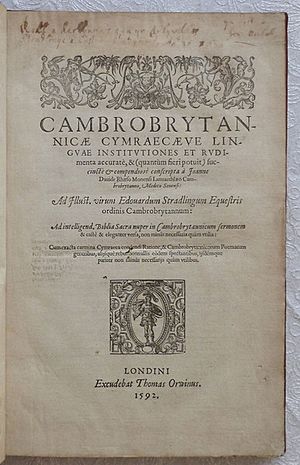Siôn Dafydd Rhys facts for kids
Quick facts for kids
Siôn Dafydd Rhys
|
|
|---|---|
| Born | 1534 Llanfaethlu, Anglesey, Wales
|
| Died | c. 1609 Clun Hir, Brecknock, Wales
|
| Nationality | Welsh |
| Other names | Latin: Joannes David Rhaesus |
| Occupation | Physician and grammarian |
| Known for | Cambrobrytannicae Cymraecaeve linguae institutiones et rudimenta (1592) |
Siôn Dafydd Rhys (born 1534, died around 1609) was a clever Welshman who worked as a doctor and a language expert. He is famous for writing the first ever Welsh grammar book in Latin. This important book was published in 1592. In Latin, his name was Joannes David Rhaesus, and he was also known as John David Rhys or John Davies.
Contents
Early Life and Education
Siôn Dafydd Rhys was born in 1534 in a place called Llanfaethlu on Anglesey island in Wales. His family wasn't rich, but they had a connection to a group called uchelwyr, who were like minor nobles.
A family story says that his father, Dafydd Rhys, came to Anglesey to work as a gardener. He worked for Sir William Gruffydd, whose wife was from St Donats in Glamorganshire. Siôn's father married one of the people who helped the bride. Sadly, Siôn's parents died when he was young. He was then raised and educated by the Stradling family at St Donats.
Studying at Oxford and Abroad
In December 1555, Rhys started studying at Christ Church, Oxford University. However, he left before he finished his degree. He married Agnes Garbet, and they had seven sons together.
After leaving Oxford, Rhys went on a long trip around Europe. He visited places like Venice, Crete, and Cyprus. He might have traveled so much because he was interested in Catholicism. He also studied at the University of Siena in Italy.
On July 2, 1567, after a two-day public exam, he earned two degrees. He became a Master of Arts and a Doctor of Medicine. This happened in the big hall of the Archbishop of Siena. It seems he didn't work as a doctor in Siena itself. He later taught for a while at a school in a town called Pistoia. In Pistoia, he was a private teacher for the sons of Vincenzo Gheri, whose family was connected to the powerful Medici family.
Returning to Wales
In the early 1570s, Rhys came back to north Wales. He became the headmaster of the Friars' Grammar School in Bangor. In 1577, a bishop named Bishop Richard Davies invited him to his palace near Carmarthen. It's possible the bishop wanted Rhys to help translate the Old Testament into Welsh, but this didn't happen.
Rhys moved to the Cardiff area in 1581. By 1583, he had started working as a doctor in Cardiff. Later, he moved his doctor's practice to Blaen Cwm Llwch, which is at the foot of the Brecon Beacons mountains. In his later years, he spent all his time working on his important Welsh grammar book.
A man named Edward Stradling (1528/29–1609) paid for Rhys's Welsh grammar book to be published in 1592. A famous Welsh poet, Meurig Dafydd, even wrote a special poem for Stradling and Rhys when the book came out.
Siôn Dafydd Rhys passed away around 1609 in Clun Hir, Brecknock. His son, Walter Rhys, was a vicar (a type of priest) in Brecon from 1576 to 1621.
Siôn Dafydd Rhys's Writings
While he was in Italy, Rhys published a book called De Italica Pronunciatione in 1569. This book carefully described how to make vowel and consonant sounds. It showed that Rhys knew a lot about the main languages of Europe. It was a very early and important book about how we use our mouths and throats to make speech sounds. While in Pistoia, he also wrote a Greek grammar book, but it has been lost. He also published a Latin grammar book in Venice that was very popular, but it seems to be lost too.
The Welsh Grammar Book
Rhys's most famous book is Cambrobrytannicae Cymraecaeve Linguae Institutiones et Rudimenta, published in 1592. This was the first grammar book about the Welsh language written in Latin. Latin was the main language used by scholars and educated people at that time.
The book was dedicated to Sir Edward Stradling. It included Latin poems praising Rhys from other scholars. It also had a Welsh introduction written by Rhys himself. The book contained a grammar of the Welsh language, a discussion about the art of Welsh poetry, and a collection of Welsh poems.
Some parts of the grammar book are not very useful today. This is because Rhys tried to make the Welsh language fit into the rules of Latin grammar, which didn't always work well. His section on Welsh poetry was very long and sometimes hard to understand. However, the book is still valuable because it saved some information that we wouldn't know otherwise. Rhys also wrote a lot about how to spell and pronounce Welsh words. He believed it was important to have clear symbols for different sounds. His new spelling ideas were used by some other writers, but they were never fully accepted by everyone.
Rhys also wrote a long paper about the early history of Britain. In it, he defended the historical stories found in Geoffrey of Monmouth's Historia Regum Britanniae. He argued against other writers who said these stories were not true. It is also said that Rhys translated Aristotle's Metaphysics (a book about philosophy) into Welsh. This translation was once in the library of Jesus College, Oxford. The National Library of Wales has a Welsh translation by Rhys of a Latin poem that praised St Donat's.
Images for kids



